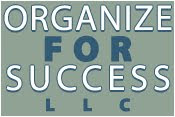As new technology is created, there are more and more options, and it can be very overwhelming... I mean, have you seen all the cloud options for storing and sharing data?!? Wow! The key, though, is how each tech option makes your life easier, more organized and more productive. Read on for a little clarification about various available tools and what differentiates them...
Notes-Keeping Options:
Although Yojimbo and Growly Notes are Mac-only while OneNote caters to the needs of PC users, Evernote works in both the Mac and PC realms, making it easy to organize all information in one, reliable solution. Plus, whereas there is a fee to use any form of either Yojimbo or OneNote, there is a fairly robust option for Evernote that is absolutely FREE... Such a beautiful word, eh? With each of these tools, you can store text, images, PDFs, checklists and more, organized with tags, by labels or in groupings / notebooks and easily searchable. Access your Evernote or OneNote account via the Internet, on your computer's desktop or on your smartphone and access your Yojimbo or Growly Notes account anywhere data is synced through MobileMe.
Options to Aid in Creating a Paperless System:
Both Shoeboxed and OfficeDrop offer mail-in scanning services, where you package your papers in pre-paid shipping for those companies' employees to coordinate scanning your documents into an organized, electronic format for you. However, if you prefer to scan your own documents for yourself, there are several other options... The Neat Company offers NeatReceipts as a portable option and NeatDesk as a desktop scanner, allowing you to scan your business cards, receipts and 8.5" x 11" documents into a digital filing system. Both Canon Document Scanners and Fujitsu ScanSnap Scanners offer mobile, personal, sheet-fed and network options to scan your documents. Although each self-scanning device integrates differently with collaborative solutions, like Evernote, the option for you may depend most on current pricing so it's recommended that you research online before buying.
File Collaboration, Sharing, Syncing and Back-up Options:
If you are looking for a tool that relies solely or primarily on you manually moving a document from your computer to the cloud or web-based solution, there are plenty of options available. A free account through Dropbox gives you 2GB of storage for life, but a paid account will increase your Dropbox storage capacity; any file can be shared from Dropbox via the appropriate URL. Windows Live SkyDrive is very similar but is limited to PCs and bumps the storage limit up to 25GB with a 50MB cap for each file. A free account through Ge.tt gives you quicker, real-time storing and sharing of files for 90-day intervals. Furthermore, MediaFire has no restrictions except that files be smaller than 200MB. A free account through Box.net gives you 5GB of storage with a 25MB cap for each file, including a collaboration "holtlink" for any shared files. And the very popular option of Google Docs can be found at Docs.Google.com to upload files from desktop, access them from anywhere and do real-time collaboration with others.
On the other hand, if you are looking for a tool that will move documents from your computer to the cloud automatically, the available options are a little different. With these options, you simply install the technology on your computer (PC or Mac) and, at different intervals when your computer is connected to the Internet, your selected data will automatically be encrypted and securely backed up to the cloud, allowing you to restore or remotely access as-needed later. In February of this year, Mozy replaced its unlimited backup plan with a tiered storage plan of 50GB or 125GB, allowing users to purchase additional storage in increments of 20GB each. If you are looking for an unlimited option, Carbonite offers such a solution for $59 a year while the unlimited solution from Crash Plan is $49.99 a year, but Crash Plan has smaller storage options for less money, too. And there's good news... In addition to the aforementioned manual option, Windows Live Mesh's SkyDrive also offers an automated sync for PCs, too!
Finally, Amazon Elastic Compute Cloud is a web service that offers a customizable, pay-as-you-go option for storing in a cloud environment, allowing you to quickly scale capacity up or down and pay only for the capacity that you actually use. For details on this new and different option, I recommend visiting http://aws.amazon.com/ec2/.
Options Enabling Remote Access to Paperless System:
Now that you've created all these electronic documents, some will be accessible via Internet access through cloud technology; however, sometimes, you just want to work with them on your own computer. If you travel a good deal, options for accessing your own computer via the Internet from a remote location might be very helpful, and there are several options for accomplishing that goal. LogMeIn and GoToMyPc allow you to access, support and manage devices (including Windows-based PCs and iOS-based Macs) at any time from any location via a secure, Internet login. Or you can use Windows Live Mesh to work on your PC from another location, running programs or browsing PC files remotely. Finally, if you have an iPhone or iPad, use Mocha VNC to connect to your Windows PC or Mac OS X and see your files/programs exactly as you would sitting in front of your computer itself.
Smartphone Solutions for Working with Documents:
Although many of the aforementioned tools enable access from your smartphone, a growing number of people elect to work via smartphone, rather than focusing on use of desktop and laptop computers. Quickoffice Connect and Documents to Go - Office Suite are options to create, edit and share Microsoft Office documents on your iPhone, iPad, Android technology or Blackberry.
Do you utilize cloud technology and, if so, how do you upload data to "the cloud"? Are you backing up data automatically or adding it manually? Which tools do you prefer most? Please share in the Comments below.

